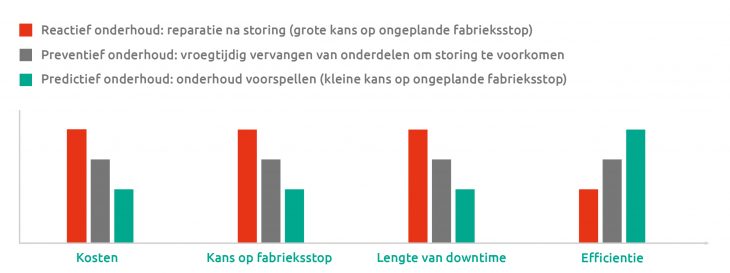Maintenance Strategies
Machine maintenance can be a significant cost for a factory, but with the right strategy, investments can be recovered, and costs can be reduced. Ensuring that a process doesn’t have to be unexpectedly halted due to a defect allows a factory to operate optimally, avoiding unnecessary expenses. Additionally, well-functioning parts are not unnecessarily replaced, which could otherwise continue operating for months.
In the industry, four different maintenance strategies are commonly distinguished for machine maintenance. Depending on various factors, the appropriate strategy for the process in question can be determined:
- Reactive maintenance
- Periodic maintenance
- Preventive maintenance
- Predictive maintenance
Reactive Maintenance
In reactive maintenance, machine parts are only replaced when they are actually broken. The process is only halted when necessary, but this often creates time pressure on engineers, leading to potential errors or unsafe situations. Additionally, an entire batch of products may need to be discarded. While this strategy may not be ideal, it can work in certain situations, such as when a factory produces on one day and processes on another.
Periodic Maintenance
Periodic maintenance involves performing maintenance at fixed intervals, such as weekly, monthly, or yearly. Another metric could be the number of active operating hours.
Preventive Maintenance
In preventive maintenance, parts are replaced proactively to prevent a production stop or defect. However, this strategy does not provide a 100% guarantee that no issues will arise during the process. It is also costly but can be applied when a breakdown during full production would lead to even higher costs.
Predictive Maintenance
Condition-based maintenance, also known as predictive or condition-dependent maintenance, involves monitoring the status of a machine to create a trend analysis. This is possible when periodic or continuous measurements are conducted on a machine. The equipment required for predictive maintenance can be expensive, so this form of maintenance is typically applied to critical machines in a process, such as steam turbines, gas turbines, generators, and compressors.
Condition-Based Maintenance
Predictive maintenance is made possible through machine condition monitoring, also known as condition monitoring. There are several ways to measure a machine’s condition, and the appropriate method depends on the type of machine. Methods include:
- Vibration measurements
- Infrared measurements
- Oil sampling
We specialize in vibration measurements on machines, so we will focus on that topic.
Vibration Measurements on Machines
For machines with rotating parts, such as steam turbines, gas turbines, generators, and compressors, condition monitoring through vibration measurements is a reliable method of machine condition monitoring. Vibrations at different frequencies and how vibrations increase can reveal the condition of bearings (both rolling and plain bearings), the accuracy of machine alignment, imbalance, etc.
Specialists can use data generated by vibration sensors to identify where problems are occurring, where issues are developing, and when maintenance will be needed. This predictive approach allows maintenance to be coordinated with a scheduled turnaround or determine if a stop needs to be planned. As a result, condition-based maintenance is cost-effective, and the risk of unexpected stops is minimized.

